A couple weeks back I talked a bit about the tiresomeness of the strong female character trope. And I don’t disavow that: strong female characters, who all know kung-fu and never take no shit, remain tiresome. But Megumi, the main character in Kazuo Umezu’s one-volume manga “Butterfly Grave,” reminds you why, tiresome as they are, those strong female characters are generally seen as preferable to the alternative.
Megumi is the alternative. She is not strong. She is weak…and holy shit is her drippy, unrelenting weakness incredibly annoying. Virtually all she does, throughout the entire manga, is whine, cower in tower, and then, sometimes, for variation, whine some more. Her one character trait is an overwhelming phobia of butterflies, and when she is not shrieking and running from some fluttering assailant, she is trembling and helplessly agonizing internally about how terrible it is that she is always shrieking and running from the fluttering assailants. When even Umezu tires of that, he has her start seeing phantom black butterflies everywhere, resulting in more cowering, additional agonizing, and, if you’re me, a fair amount of fervent wishing that the horror manga would get on with the horror and kill her off in some gruesome fashion — preferably with collateral damage including her colorless father, her colorless boyfriend, the colorless kids at her school, and perhaps (if you’ll forgive me) the banally uninventive manga-ka who has inflicted all of them upon me.
As this suggests, Megumi’s spinelessness, and consequent shapelessness, is more than just a personality trait; it’s a kind of miasma which infects the entire manga. Umezu’s Drifting Classroom, which focuses on the Bildungsroman of a male protagonist, has a grim, ineluctable structure, racing forward in an ever-rising body count towards an ever bleaker future. “Butterfly Grave”, on the other hand, vacillates in a sodden nowhere. There are events, and more events, but they never add up to anything or go anywhere. Megumi is scared by butterflies; Megumi is scared by the grotesque but harmless gardener; Megumi is scared by a dream in which her dead mother rises from the grave as a butterfly. The whole middle section of the manga is given over to little episodes where Megumi sees an ominous black butterfly, and then disaster strikes (a car loses its breaks; there’s an earthquake.) This seems to be building somewhere…but no. Umezu just abandons it. When Megumi’s fear of butterflies is eventually explained, her predictive powers aren’t so much rationalized as simply forgotten. The story — Megumi’s story — doesn’t matter, because she doesn’t really have a story. She just has the ritual repetition of terror and weakness.
Nonetheless, and almost despite itself, the manga does heave lugubriously into a kind of plot. Megumi’s mother (given to unaccountable fits of terror like Megumi herself) died soon after Megumi was born, killed in a fall from the balcony of the house. Eventually, Megumi’s father decides to remarry a woman he has known for a long time…a woman who, as it turns out, is evil, evil, evil. It is she, the new second mother, who killed Megumi’s actual mother, pushing her off the balcony as she clutched Megumi to protect her. In the climactic scene, this murder is recreated; the evil mother tries to push Megumi off the balcony, revealing in the process a butterfly shaped birthmark. Thus Megumi’s fear of butterflies — it’s all a infantile psychological thingee, don’t you know.
The explanation doesn’t make a whole lot of sense, but again narrative closure, or even coherence, isn’t really the point. On the contrary, narrative incoherence is the point. The butterfly “revelation” tends not to provide linear closure, but to turn the manga into a closed fuzzy circle — or perhaps a blurred shadow, like the birthmark itself. Megumi takes the place of her mother as victim. But the mother has also been insistently associated with the butterfly, as in this dream sequence.
Thus, mother and step-mother are butterflies, and mother and step-mother end up also being substitutes for each other. And if mother is Megumi, and mother is step-mother, then step-mother and Megumi are also the same…a point underlined when the step-mother, like the mother, and almost like Megumi, falls to her death from a height (a cliff face rather than a balcony, but still).
I’ve been reading several articles recently which reference the work of Nancy Chodorow, a feminist psychoanalyst who argues that female ego-formation is less complete or rigid than male ego-formation; that the boundaries of women’s selves are more permeable because daughters identify with mothers, and eventually with their own daughters/children. Whatever it’s application to real women, Chodorow’s ideas have an obvious application to “Butterfly Grave”, where Megumi both barely has a self and is transposed with multiple mothers, who in turn keep becoming dis-embodied and turned into soft, shadowy things, grotesque butterfly non-forms.
Throughout the manga, Megumi keeps asking herself “Why am I afraid of butterflies?” The answer, diegetically, is that she is afraid of her step-mother. The answer, thematically, is that she is afraid of her mother.
So why is she afraid of being her mother? Mothers are good things you’d think. Megumi’s mother sacrifices her life so her daughter won’t die in the fall from the balcony. This is initially described as an accident; Megumi crawled out into danger, and her mother rushed to save her.
The mother gives her life and saves Megumi…but if Megumi is the mother, or is to be the mother, then the sacrifice is also an imperative that she, Megumi, die — to be a mother is to give up the self. Thus, the mother is the victim of Megumi who causes her fall accidentally, and/or of the stepmother (who is also Megumi) who murders her. But the mother is also the murderer, the woman you will be who demands you give up your self. Mother murders daughter, daughter murders mother, in a perfect glob of girly-butterfly passive-aggressive doom.
In the manga, the step-mother hates Megumi’s mother because she wants her father — a neat Oedipal drama, if the step-mother is a stand-in for Megumi. But really there’s little energy invested in the het-plot, which seems mentioned only to show us how irrelevant it is. The real change in the step-mother’s behavior comes after Megumi’s attack on hert’s not love which leads to aggression, but loss of self — both in the sense that Megumi is not herself when she attacks, and in the sense that what provokes the attack is the step-mother not being herself, but an amorphous other, which is also Megumi.
The manga ends happily; the step-mother has killed herself, Megumi isn’t freaked out by butterflies anymore, and — significantly — Megumi has her own daughter, who isn’t afraid of butterflies either. The last image is of the mother and daughter looking calmly out the window at a group of butterflies flying past; white rather than black, the blurred, shapeless shapes are domesticated and contained in the comforting grid of window panes, and the domestic arc of the curtains.
Or that seems to be the last image. In fact, on the overleaf is one final drawing — Megumi’s frightened face, screaming, disappearing into whiteness.
It’s not clear how this image fits into the story narratively. But thematically and visually, it links Megumi to the white butterflies, and simultaneously replaces domesticity with dread. Maternal peace suddenly becomes merely a continuation of Megumi’s monotonous terror. Megumi’s happy ending is her worst fear; she’s finally a mother, and so her self — which was never anything but her terror — fades to white. Instead of a strong female character, Umezu gives us woman as mother, which is also, in this vision, woman as void.
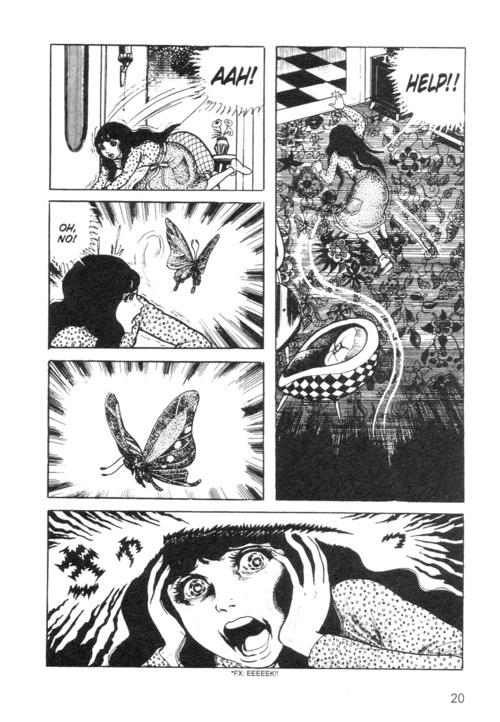
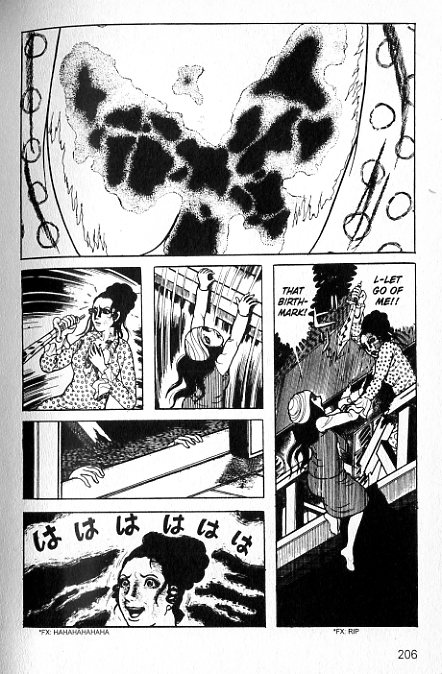
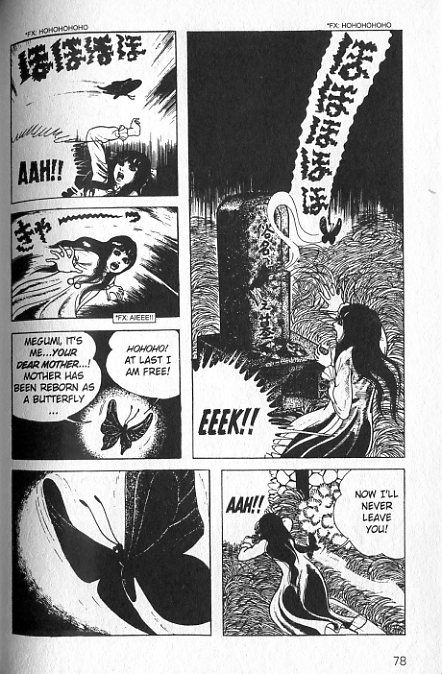
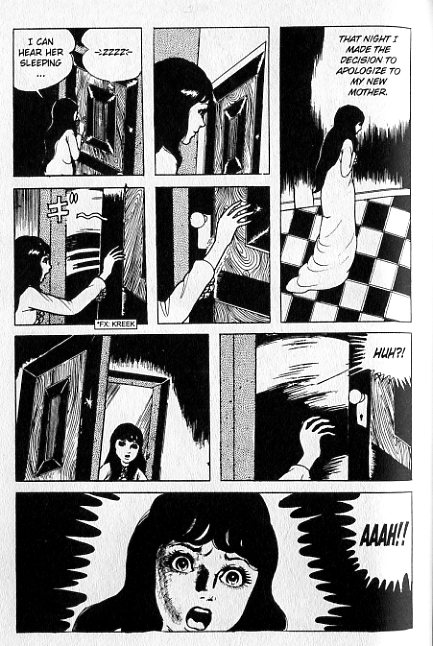
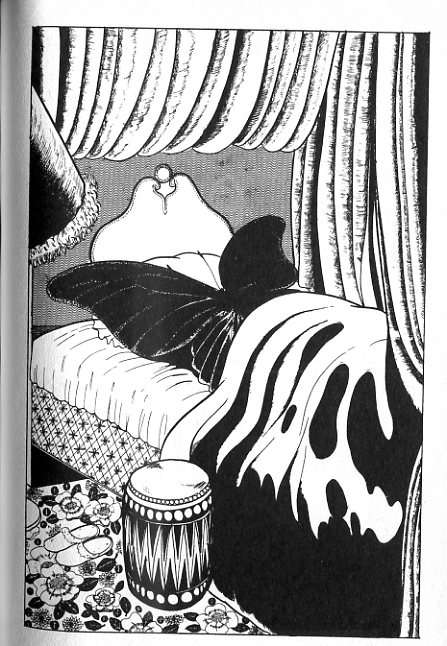
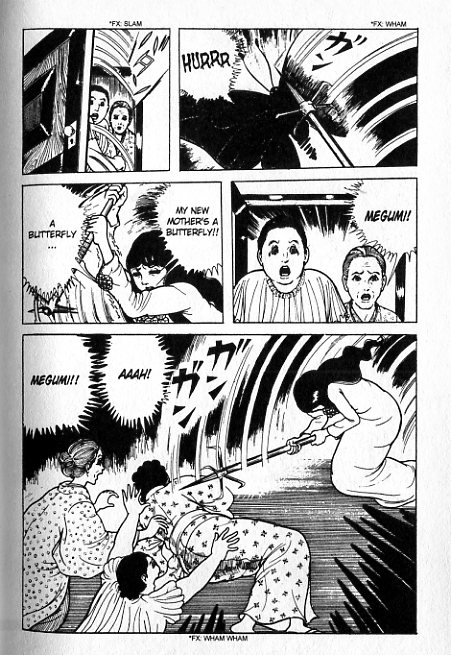
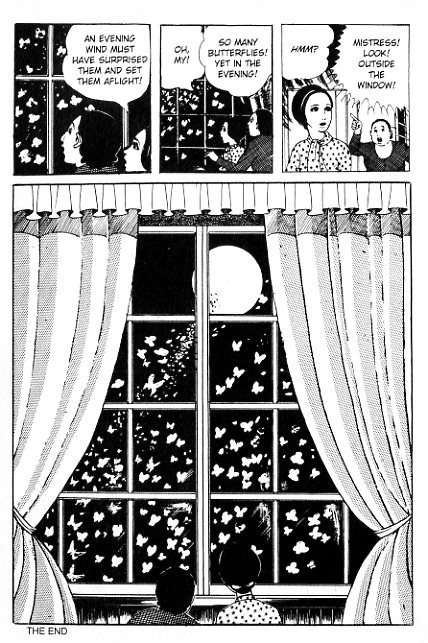
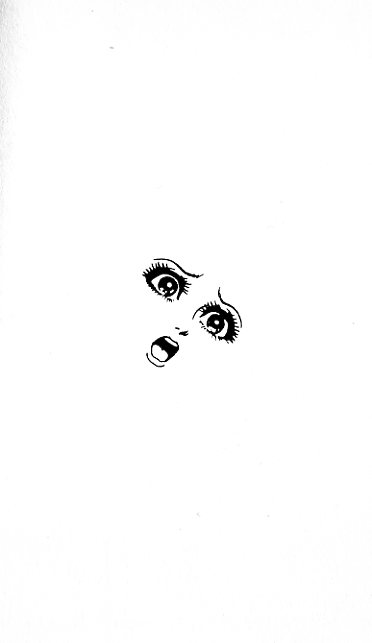
“The explanation doesn’t make a whole lot of sense, but again narrative closure, or even coherence, isn’t really the point. On the contrary, narrative incoherence is the point.”
More true than you would think, especially in his later works. This one is really C-level Umezu Kazuo though. I have no idea why Dark Horse chose to translate this one when so many other better works are still lying around. My guess – it’s less violent and hence more acceptable to the American market.
As for the weak heroine, she is supposed to be psychologically disturbed and mentally ill right? Something like Catherine Deneuve in Repulsion. Also, if your mother died at child birth and you have suppressed memories of murder, then survive a near fatal car crash and earthquake, see your father go blind, watch as your classmates get killed by a truck, get locked in an insane asylum, see your nanny hanging from the rafters, and almost get killed by your step-mother – you can sort of be excused for going semi-insane. But strangely enough, all this horror seems to cure her in the end. I think they call that shock therapy.
Also note, she doesn’t marry the colorless boyfriend. In fact all the colorless people in the manga are dead or disappeared at the end of the story.
A lot of Umezu’s stories actually prey on his young readers’ suspicions of their parents. These suspicions are frequently found to be valid. Perhaps this has something to do with Erik Erikson’s idea of a child’s development of trust/mistrust evolving from their early years (as is the case in this butterfly story). Certainly the biggest bogeyman in Umezu’s comics seem to be mother and father. Megumi, by having a child, does actually become the object of dread. I don’t think this happens very often in American horror. Does that whiteout-face belong to Megumi or her child?
The face looks like Megumi to me, but I’d say the fact that it could be either is thematic; again, mother and daughter blur together.
The point I think is that when boys (as in Drifting Classroom) are faced with trauma they fight and overcome. That’s not the case with girls.
Interesting that they chose the less violent ones. You’d think more violent would be the more commercial choice.
The guy has drawn stacks and stacks of manga, and a lot of them have heroines in them. Some of them are passive, some of them a bit more active in dispatching the baddies. It gets boring doing the same thing over and over again I suppose. Sometimes you want to put your young readers in a position of helplessness. Don’t think it worked this time though.
I took out the manga to check. According to the indicia, the manga was created relatively recently (?2003). I wonder if this is accurate. It also says published in “Asahi Sonorama” which is a publishing firm so only partially helpful. Was this published in Nemuki – their shojo magazine? Maybe someone with more knowledge can tell us.
Also found this Junji Ito interview where he states the following:
‘Kazuo Umezu has been my favorite comic artist for as long as I can remember. His work is very inspiring. When I draw comics I’m influenced by his work without even realizing it, and I believe many other artists are too. His comics leave a lasting impression due to high quality art and compelling storytelling. I don’t think any horror artist can surpass him in Japan. My favorite Umezu comics are “Drifting Classroom,” “Fear,” and “The Grave of Butterfly.”’
So maybe part of the reason for its publication was its reputation among some connoisseurs (and its availability from the publisher of course).
This is one of Ito’s favorites? That’s just bizarre.
The book seems to have originally been published in 1981:
http://goo.gl/dhSkjo
Great article! As a minor aside on the violence issue, it all depends on who it’s marketed at, doesn’t it? Dark Horse does have its ’18+’ titles like Gantz, where they actually want to emphasize the gore etc., but publishers of manga rated for teens & tweens definitely want to avoid violence and gore insofar as possible. It’s simply too controversial, too much risk of offending parents, etc. I’ve seen many YA manga censored for violence, although probably less so in the last few years, since the manga market has sunk and there’s not so much attention on it anymore.
In addition, much of Umezu’s later work (prior to his retirement in the ’90s) is some of the goriest stuff ever committed to paper in any medium. (It’s made even gorier by the REPETITION of imagery, the sheer feeling of having your face rubbed in it, panel after panel.) Since it involves violence against children (and, in some cases, the implication of sexual violence) publishers might understandably shy away. Umezu/Shogakukan wanted Viz to publish “Fourteen” back before the bust, but Viz had to respectfully decline because they believed it might qualify as child pornography.
I think that’s all irrelevant to the choice of translation of “Butterfly Grave” though. I don’t know why Dark Horse published it, but they were probably just digging around in Umezu’s back catalog for ‘classics’; after all, IDW published the equally dusty “Reptilia” only a few years later. Visually at least, for my own part, my favorite Umezu work is “Left Hand of God”, which falls into his later gore-trash period but doesn’t collapse into a sloppy heap of goop like “Fourteen” (and so many of the characters in “Fourteen” for that matter). But such longer works are a much bigger publishing investment.
Jason, do you know why Viz released only the last volume of Orochi Blood?
I’ve also wondered if there is much more horror manga comparable to Umezu, Ito, Hino and Maruo? Whenever I search for horror manga it mostly comes up with stuff that I dont think is a good stylistic fit for the genre, or at least not good if you want to accomplish the traditional horror effects.
Ito seems to have a fairly big following so why did it stop with Uzimaki, Gyo and only the first 3 volumes of Museum Of Terror? If only I could read french I would get all those Ito books, loads of them on amazon.
Last Gasp put out a book called something like Scary Horror Manga, but I can find out almost nothing of its existence anywhere apart from adverts and some people mentioning it on forums. How could it be so rare and barely recorded on the internet?
I just had a thought recently that Umezu’s Cat Eyed Boy and Hino’s Oninbo look like they take after Mizuki’s Gegege No Kitaro.
I’d highly recommend watching The Curse Of Kazuo Umezu on youtube. The animation isnt very animated but the first story is very effective and I’d love to see his original version of it.
I have a feeling that Umezu was a big influence on survival horror games, especially the Clock Tower series. Maybe it is just a general japanese feel, but I just have a hunch that the feel and structure of these games was influenced by him.
I thought the 3 Darkhorse volumes of Scary Book were quite weak and I didnt bother finishing the last two volumes, but I did think the Samurai revenge tale was good despite the crudeness of the art.
I think that last page of the screaming face in white is just a design element of the series (see that the japanese editions in the link above uses this image)and not part od the story.
When I had given up on fully reading the butterfly story and just looked at the pictures, I had assumed that the birth mark revelation was that the woman had breast fed her and she had vague unpleasant memories of the birth mark from early childhood. But that is probably just me reading my own obsessions into the work.
Noah- This might seem a bit out of nowhere but I just want to say I think you’re a really great guy and I think you deal with a lot of unfair antagonism on various sites very admirably. Hugs from me.
Huh; that’s kind of great if it’s just a design element. I still like my reading!
And hugs to you too!
Also, even if he handled it badly in this story, I think making characters weak in horror makes a lot of sense. Many horror fans like feeling powerless.
There is a horror trope which I dont know if anyone has ever named or talked about which I’d call “the empowerment moment”; I hate it. It happens in one of the Alien films, Carpenter’s The Thing, Relic and the Evil Dead remake. When a character gets some sort of weapon or upper hand and shouts “fuck you” and kills the monster. I dont think the audience should be allowed that satisfaction and I think it spoils things.
I’m not saying people should never feel empowered in horror stories but I think my examples of doing it in the wrong place.
Right; the final girl reversal moment.
I can be okay with that; depends on how it’s done. But the feel good happy ending horror movie like the Conjuring definitely leaves me depressed.
Oddly, this story reminds me strongly of the Hitchcock film ‘Spellbound’, with the Gregory Peck character traumatised by images of parallel lines standing in for Megumi…simplistic psychology is a nice cheap form of plot contrivance
Yep; I thought of Hitchcock too….
Hi Robert! Sorry I didn’t see your post, it looks like I forgot to subscribe to the thread.
I’m not really sure why Viz didn’t publish any more Junji Ito, since Uzumaki certainly did well. Gyo did less well, but I don’t think it did astoundingly badly… my guess as an ex-employee is just that, as the market emphasis shifted to YA stuff (and PULP magazine, which had nurtured Uzumaki, died) all the attention went to other stuff. Viz stopped that whole line due to apathy, rather than a conscious decision not to publish any more horror.
Sadly, I don’t remember why Viz only published the last volume of Orochi (one of my least favorite Umezu manga, incidentally, just because I can’t forgive him for so blatantly copying “Whatever Happened to Baby Jane”). I think it probably sold poorly. I don’t remember why they started with that particular volume; maybe someone who hadn’t seen “Baby Jane” thought it was the best in the series.
I totally agree with you that the point of pure horror is dragging the audience through anxiety, suffering and fear rather than providing any kind of revenge or empowerment. Still, it’s a tricky balance because even I feel a certain Wertham-y moral indignation at horror that I feel is *glorifying* the ‘bad guys’, or merely enjoying/mocking the victims’ sufferings, rather than making the audience empathize with the victims/protagonists… the kind of effect where audiences would cheer for Freddy Krueger or Jason Voorhees, or where the victims are somehow morally flawed (because they were jerks, or bigots, or had premarital sex, or whatnot), or just ‘too dumb to live’ (because they stupidly let the zombies into their apartment, etc.).
It all depends on the audience and the effect the creator is going for, I guess. I hate horror where the audience is encouraged to mock the sufferings of others, or have a revenge-power-fantasy of being Hannibal Lecter or Dexter (although I do love an ACTUALLY well-done ‘glimpse inside the mind of a lunatic’, like Robert Bloch’s/Hitchock’s “Psycho”, and I appreciate a J.G. Ballard or David Cronenberg who can present a complete moral breakdown scenario without seeming to wallow in it). I like bleak endings. OTOH, occasionally some surprise catharsis can be nice, whatever Michael Haneke thinks. -_-
Kim Newman (who seems to rate Haneke quite highly) in the updated version of Nightmare Movies described Haneke’s style as “look what you made me do!” That made me laugh a lot and I think of that everytime Haneke is mentioned. I liked Piano Teacher a lot but never been interested to go any further.
I cant say I’ve really worried much about bad guys being glorified or mocking suffering of victims. What troubles me more is when a story makes you hate someone and want them dead. But I cant really say if the creators are wrong or if you should not allow the audience to hate a character.
In films as different as Merantau (martial arts evil sex traffickers), The Crucible (hysterical christians turning on each other), Magdalene Sisters (horrible nuns); I was filled with anger and violent feelings. I’m white and Ip Man 2 almost made me hate white people, haha.
I think martial arts films are particularly bad for manipulating your anger. I dislike how in a lot of Jackie Chan films, you are asked to sympathise with him at all times, but when he humiliates someone else, youre always supposed to laugh.
I’ve always remembered an old Peter Jackson interview when he denied his gore films were violent. He said films that made you hate and want to kill someone were real violent films.
I certainly have my preferences in horror (strongly leaning towards romanticism and aesthetically driven horror) but I’m reluctant to say what should and shouldnt be in the genre because it really is lots of subgenres for lots of different types of fans and I tend to believe that any approach can be done very well. That’s why is didnt quite say empowerment was flat out wrong or that the traditional modern manga style was wrong.
I also dont like it when horror fans feel like they have ownership of vampires and werewolves. I dont like dogmatic genre definitions.
…but yeah, is there much more from japan that tickles the same spot as Umezu, Ito, Hino and Maruo?
“I certainly have my preferences in horror (strongly leaning towards romanticism and aesthetically driven horror) but I’m reluctant to say what should and shouldnt be in the genre because it really is lots of subgenres for lots of different types of fans and I tend to believe that any approach can be done very well.”
That’s totally true, I couldn’t agree more. I was only speaking of my personal tastes and what I look for in horror (which can be different things at different times).
As for your actual question about finding other good untranslated horror mangaka…… actually, it’s hard for me to think of other horror authors I like as much as those four! There’s an excellent blog called “spiraphobia” that posts images and reviews of/from horror manga that might have some good suggestions. I can’t call it particularly ‘weird’ or semi-underground in the style of the 4 authors you cite, but one recent manga I discovered from that blog is Kengo Hanazawa’s running-zombie action horror manga “I am a Hero”. It’s a seinen action piece, very slick, but just SO well done and immersive in the awfulness of its situations. Also, it takes 200 pages of glacier-cool-and-slow buildup to get to the explicit horror… I wish American comics could get away with those leisurely page counts. It’s still running in Japan, so there’s plenty of time for it to jump the shark, but so far I love it.
I used to visit that site now and then. But that guy is new to me. Thanks.
http://spiraphobia.tumblr.com/recommendations
…some of these artists who I’m not familiar with look not bad, Hideout looks interesting, but I’m a fickle guy.
I’m wondering how much his taste is excluding because there is no Shindo films or Yotsuya films in the film list link and those are some of the basics he has probably seen. I just saw the two of the 50s Yotsuya films a few days ago and the color one is really great.
I’ve always hoped that there was a treasure trove of horror comics in japan waiting to be discovered. Some of the stuff in Manga Zombie really got me excited, I especially want to read Saint Muscle and Rapist Monk (I presume any official translation would have to be called Defiler Monk as I’ve also heard it called).
I’m curious if Korea and Hong Kong have much along those lines. I know that the philippines has an abundance but their style has always been more connected to american comics and they look mostly identical to 70s DC horror. South America, Spain and Italy have quite a lot; although I always have a lust for horror and fantasy that is out of reach (and seems full of promise because your expectations go crazy), I know that inevitably I wont like most of it.
BTW, I’m not sure what Fantagraphics horror manga book you’re talking about. If you remember the title, let me know!
I do have a partially bilingual book (very partly, only titles and headings are in English) called “Japanese Scary Manga Illustrated Book” from the publisher Softmagic. It consists of covers and synopses from a ton of horror manga from the ’70s and ’80s, mostly obscure stuff probably chosen for its covers’ visual splash, but including Hideshi Hino.
Yes! That’s the book I’m talking about. I saw it advertised as being sold through Last Gasp, so I assumed that was the publisher.
Does the obscure stuff look good?
Some other questions…
Do you see ebooks really encouraging more niche manga to get translated?
Has there been a change in attitudes to scanlations?
Years ago I recall there being a positive attitude about scanlations raising the profile of authors/titles but in recent years I’ve seen statements from artists asking people not to read scanlations.
I’ve seen this more from porn manga authors but maybe this is because a lot of people are less willing to pay for porn.
Is there a reason Darkhorse has been so poor at keeping Berserk in print? I’ve been waiting over a year to find reasonably priced copies of the few volumes I still need.
I’m amazed with the animated movies buzz that Darkhorse doesnt seem to have taken advantage. I’ve seen quite a few people being reluctant to buy the series because the low print runs are stopping them from completing the series.
Do you think with the new Jojo games, animations and the load of tumblr tribute sites that Jojo might come back in english?
Robert, there are now giant scanlation aggregate sites. The conventional wisdom is that they’re responsible for the curtailing of manga sales in recent years. So I think the community/creators is much more hostile than they might have been ten years ago.
Or at least that’s my sense; maybe Jason will tell me I’m wrong if he’s still about….
I adore Jojo so I’d really love it if Viz or someone else published more of it… but sales were very low so it’s unlikely. Jojo, like many manga, is a weird case because it has a lot of meme-popularity — it’s an unknown thing but a COOL unknown thing — but that didn’t translate at all into sales.
Attitudes towards scanlation vary. It’s hard for me to speak for people ‘in the industry’ since it’s been so long since I worked for Viz or Random House, but I’ve known several manga editors who weren’t fluent or totally fluent in Japanese and thus read scanlations to keep up with the current manga (and used it as ‘market research’ etc). Since I’m also not fluent, I also read scanlations of some title so I can’t take the moral high road. Heck, years ago I actually asked a friend to translate the first chapter of a Lovecraft-related manga for me, intending to post it, but I decided not to reletter it or put it online because I realized it would be unprofessional.
That said, while I respect the urge to scanlate — “scanlation isn’t the problem, it’s the solution to the problem” as Erica Friedman has said — I feel the need to draw some line between scanlation groups translating obscure titles, and the unrepentantly idiotic “we’re stickin’ it to the man” type scanlation groups who think they’re Anonymous when they’re STILL scanlating, say, Naruto, even though Viz is now releasing it basically at the same time as the Japanese. Also, as Noah said, there’s the sleazy scanlation aggregator sites that make money off all this (through advertising); some of them are even linked to bootleg merchandise stores. It’s basically the difference between one person growing pot for herself and her friends, and a huge pot farm in Yellowstone National Park with armed guards patrolling the area to shoot hikers. So anyway, I can’t object to the small scanlator/grower, but some really scummy and just idiotic groups take advantage of the myriad cracks in the manga system. That’s what I tell myself to help myself sleep at night, anyway. -_-
BTW, many Japanese manga artists have posted barbed anti-piracy comments and rants on Twitter and other places. Anime News Network has run short articles about a few of the juicier ones. Of course, interestingly from an American perspective, they’re mostly not complaining about scanlators per se…. the ones I’ve read have been complaints about (presumably) Japanese people uploading untranslated scans of the original Japanese manga! Piracy is alike all over, I guess.